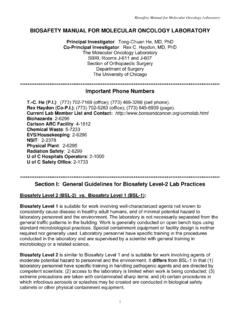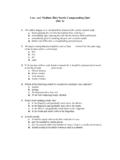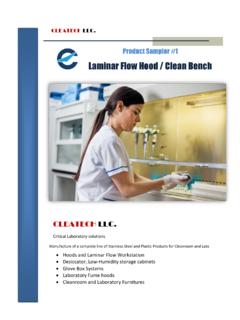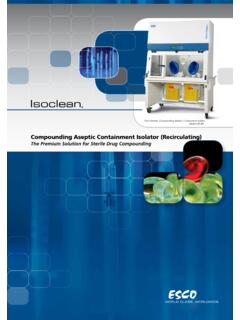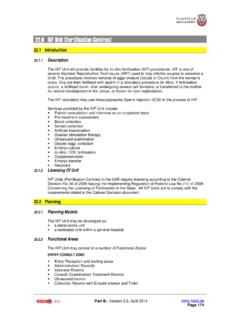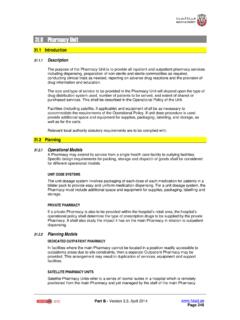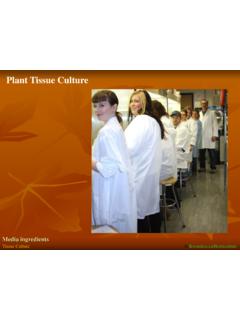Transcription of Mouse Embryo Fibroblast (MEF) Feeder - …
1 Mouse Embryo Fibroblast (MEF) Feeder UNIT Cell Preparation The production of Mouse mutants using homologous recombination and blastocyst- mediated transgenesis requires the maintenance of Mouse embryonic stem (ES) cells in an undifferentiated state. Many investigators rely on Feeder layers to prevent ES cell differentiation; Feeder layers prepared from mitotically inactivated primary Mouse em- bryo fibroblasts (MEFs) are used most commonly. This unit describes a simple method to isolate and store MEFs (Basic Protocol 1 and Support Protocol) and two common techniques for mitotic inactivation: -irradiation (Basic Protocol 2) and mitomycin C.
2 Treatment (Alternate Protocol). NOTE: All cell culture incubations are performed in a humidified 37 C, 5% CO2 incubator unless otherwise specified. ISOLATION OF PRIMARY Mouse Embryo FIBROBLASTS BASIC. PROTOCOL 1. MEFs are isolated from to postcoitum ( ) Mouse embryos. The embryos are dissociated and then trypsinized to produce single-cell suspensions. After expansion, aliquots can be frozen and stored in liquid nitrogen indefinitely. Alternatively, MEFs suitable for ES cell culture may be obtained from commercial sources (see for a current list of suppliers).
3 Commercial MEFs may be useful to researchers new to ES cell culture or to those who will grow ES cells on a limited scale. Materials Mouse embryos, to days postcoitum (Hogan et al., 1994). DPBS (see recipe), sterile Trypsin/EDTA solution (see recipe). MEF medium (see recipe) with penicillin/streptomycin Laminar flow hood Inverted microscope 100-mm tissue culture dish Dissecting forceps and fine scissors, sterilized by autoclaving or ethanol flaming 10-ml syringe and 16-G needle 100-mm tissue culture plates or 75-cm2 flasks Additional reagents and equipment for passaging and freezing MEFs (see Support Protocol).
4 1. Dissect Mouse embryos ( to days postcoitum) into 10 to 20 ml sterile DPBS. in a 100-mm tissue culture dish. Process embryos from one Mouse together. Remove embryonic internal organs from the abdominal cavity using dissecting forceps. Transfer the carcass to a clean dish with fresh DPBS. Organ removal can be done crudely. Initial dissection can be performed at the bench. Subsequent procedures should be performed in a laminar flow hood. Any Mouse strain can be used as an Embryo source. However, outbred mice or F1 hybrids will usually produce more embryos per mating than inbred mice.
5 If possible, use mice maintained in a viral-antibody-free (VAF) facility to reduce the chance of contamination. If the Feeder cells will be used during the selection of antibiotic-resistant ES cells, use embryos from a transgenic Mouse expressing the appropriate selectable marker. Appropri- ate transgenic mice may be obtained from the ES cell community or from standard Mouse vendors such as The Jackson Laboratory and Taconic. Manipulating the Mouse Genome Contributed by David A. Conner Current Protocols in Molecular Biology (2000) Copyright 2000 by John Wiley & Sons, Inc.
6 Supplement 51. 2. Rinse embryos again in 10 to 20 ml DPBS. Transfer the embryos to a clean 100-mm tissue culture dish containing 3 to 5 ml trypsin/EDTA solution. 3. Dissociate embryos by aspirating into a 10-ml syringe through a 16-G needle and expelling the contents. Repeat two to four times. Too many repetitions will reduce the cell yield. The embryos should be dissociated to the extent that they can be easily aspirated into a 5- or 10-ml pipette. 4. Add trypsin/EDTA solution to 10 ml. Mix contents by trituration, return to dish, and incubate 5 to 10 min in a 37 C incubator.
7 5. Mix again by trituration and incubate for an additional 5 to 10 min at 37 C. 6. Transfer contents to a 50-ml conical tube and add an equal volume of MEF medium with penicillin/streptomycin. Let stand 3 to 5 min at room temperature to allow large tissue pieces to settle to the bottom. 7. Remove solution, avoiding large tissue pieces, and place in a fresh 50-ml tube. Centrifuge 5 min at 1000 g, room temperature. 8. Remove supernatant and resuspend pellet in 10 to 50 ml fresh MEF medium with penicillin/streptomycin.
8 Plate cells on 100-mm tissue culture plates or 75-cm2 flasks, using approximately one Embryo per plate or flask. Add medium to a final volume of 10 to 15 ml/plate. 9. Grow cells until confluent (2 to 5 days). Monitor cell density using an inverted microscope. Change medium after the first day and every other day thereafter. 10. Passage cells by trypsinizing (see Support Protocol, steps 1 to 4), resuspending the cell pellet in 10 to 50 ml MEF medium with penicillin/streptomycin, and plating at a dilution of 1:5 to 1:10.
9 Add medium to a final volume of 10 to 15 ml per 75-cm2. flask or 10-mm plate. Using this dilution, fibroblasts from each original Embryo are now plated on five to ten 75-cm2 flasks or 100-mm plates. 11. Grow again until confluent (3 to 5 days) and freeze (see Support Protocol, steps 1 to 7) at 5 106 cells/ml. A representative vial should be thawed to check for viability. It is also a good habit to check each new batch for mycoplasma contamination using a commercial service or a PCR-based screening kit ( , Pan Vera, Stratagene; also see Cot , 2000)).
10 In addition, MEFs made from previously untested transgenic mice should be grown in the appropriate antibiotic to ensure that they are resistant to the concentration of antibiotic used for selection. BASIC MITOTIC INACTIVATION OF MEFS WITH -IRRADIATION. PROTOCOL 2. MEFs must be inactivated prior to use as a Feeder layer for Mouse ES cells. Mitotic inactivation prevents the dilution of ES cell lines with dividing fibroblasts. MEFs can be inactivated using -irradiation, as described here, or mitomycin C treatment (see Alternate Protocol).
